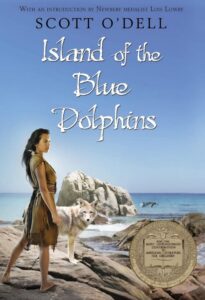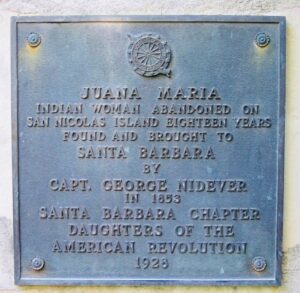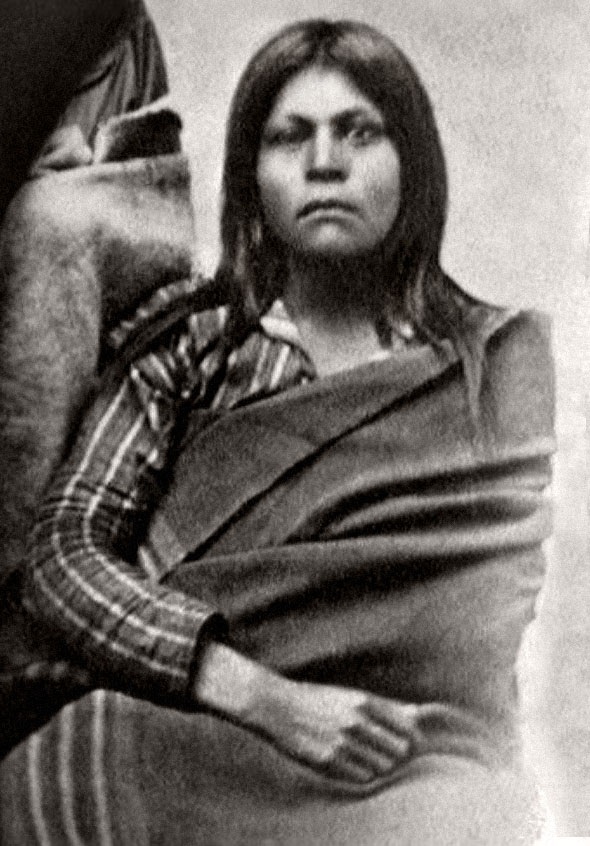by Nella Nelson
 The landscape of San Nicholas island is barren and windswept. You’re all alone. You must eat, live, and survive, making clothing for yourself. Enemies pass by or encircle the island at times. Imagine finding yourself in this very situation, but for the next eighteen years of your life. This had been the experience of an actual California native woman who came to be christened by the Spanish as Juana Maria (her native name is unknown). Also historically known as the Lone Woman of San Nicholas Island, Juana Maria’s life inspired the famous Scott O’Dell novel Island of the Blue Dolphins (1960).
The landscape of San Nicholas island is barren and windswept. You’re all alone. You must eat, live, and survive, making clothing for yourself. Enemies pass by or encircle the island at times. Imagine finding yourself in this very situation, but for the next eighteen years of your life. This had been the experience of an actual California native woman who came to be christened by the Spanish as Juana Maria (her native name is unknown). Also historically known as the Lone Woman of San Nicholas Island, Juana Maria’s life inspired the famous Scott O’Dell novel Island of the Blue Dolphins (1960).
Recalling her story from grade school in Ventura, I had until recently assumed Juana Maria to be of Chumash origin, but realized her to be the last surviving member of her tribe, the Nicoleño. As the last speaker of the Nicoleño language, the local Chumash and Tongva were unable to understand her. The Uto-Aztecan language Juana Maria spoke can be traced to north San Diego County, based on four words and two songs recorded from her (a UCLA study by Pam Munro supports this*).
San Nicholas Island remained mostly untouched from the early 1540’s claim of the Spanish by Conquistador, Juan Rodriguez Cabrillo. Then, in 1814, the brig Il’mena brought a party of Native Alaskan otter hunters working for the Russian-American Company. They massacred most of the islanders after accusing them of killing one of their hunters. The remaining islanders later got captured by the schooner Peor es Nada (“worse is nothing”), commanded by Charles Hubbard in 1835. Hubbard’s party gathered the islanders and brought them aboard while Juana Maria either hid or swam back from the boat. A strong storm approached and the Peor es Nada hurried away toward the mainland.
For the next eighteen years, Juana Maria existed on shell fish and the fat of seal. She sewed duck’s skins and feathers into clothing. One of her cormorant feather dresses was sent to the Vatican, but appears to have been lost, as noted in Island of the Blue Dolphins.
More of Juana Maria’s artifacts, including a water basket and bone needles, became part of the California Academy of Sciences, but were destroyed in the 1906 San Francisco earthquake and fire. In 1936, archaeologists discovered Juana Maria’s whalebone hut on the northernmost and highest point of San Nicholas Island. Over the next few decades, over 200 artifacts were found, including bird-bone pendants, abalone shell dishes, fish hooks, stone ornaments, Native Alaskan harpoons, and glass projectile points.
Juana Maria’s time to leave the island arrived in 1853 after Santa Barbara fur trappers searched for her in payment from Father Jose Gonzalez Rubio of the Santa Barbara Mission. After several attempts, Carl Dittman of George Nidever’s expedition, noticed footprints on the beach and pieces of seal blubber left out to dry. The lone woman was discovered, dressed in greenish cormorant feathers, in her hut. The Nidever party stayed on the island for a month, hunting and learning her way of life. By signs, she indicated that her baby had been killed by wild dogs which had infested the island. Juana Maria was then taken to the Santa Barbara Mission.
 She was reportedly fascinated by her arrival on mainland California, marveling at the horses and European food and clothing. She stayed with Nidever who described her as nearly 50 years old, strong, active, and continually smiling. She drew in curious Santa Barbara residents for whom she sang and danced. Just seven weeks later, Juana Maria died of dysentery. She was buried in an unmarked grave on the Nidever family plot at the Santa Barbara Mission Cemetery, though a plaque now stands with her name. Part of Southern California’s legacy, Juana Maria’s life will always be an intriguing story of simplicity and self-sufficiency interacting within our coastal landscape.
She was reportedly fascinated by her arrival on mainland California, marveling at the horses and European food and clothing. She stayed with Nidever who described her as nearly 50 years old, strong, active, and continually smiling. She drew in curious Santa Barbara residents for whom she sang and danced. Just seven weeks later, Juana Maria died of dysentery. She was buried in an unmarked grave on the Nidever family plot at the Santa Barbara Mission Cemetery, though a plaque now stands with her name. Part of Southern California’s legacy, Juana Maria’s life will always be an intriguing story of simplicity and self-sufficiency interacting within our coastal landscape.
Sources:
https://web.archive.org/web/20150306133039/http://score.rims.k12.ca.us/score_lessons/dolphin/teacher/karanapic.shtml
Munro, P. (1994). Halvorson, WL; Maender, GJ (eds). Fourth Multidisciplinary Channel Islands Symposium. Santa Barbara Natural History Museum 659-668.
O’Dell, Scott. Island of the Blue Dolphins 1960
PBS www.pbssocal.org
View videos and photos of the artifacts at:
https://www.nps.gov/chis/learn/photosmultimedia/california-islands-symposium.htm
Photos:
Illustration of Nicoleño woman, Juana Maria, from James M. Gibbons’s “The Wild Woman of San Nicolas Island”, published in Californian Illustrated Magazine 4, no. 5 (October 1893) James M. Gibbons (presumably) – http://calliope.cse.sc.edu/lonewoman/home/108

